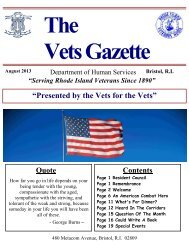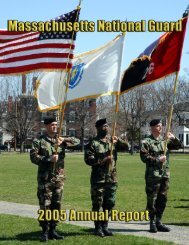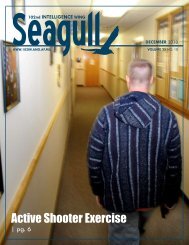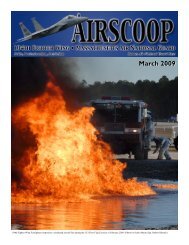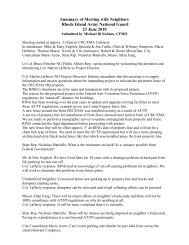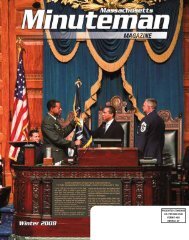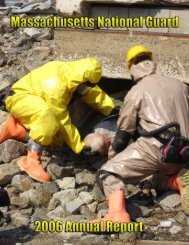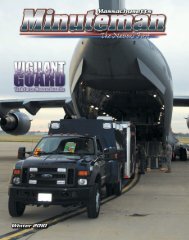CAPITAL GUARDIAN / Fall 2008 - STATES - The National Guard
CAPITAL GUARDIAN / Fall 2008 - STATES - The National Guard
CAPITAL GUARDIAN / Fall 2008 - STATES - The National Guard
Create successful ePaper yourself
Turn your PDF publications into a flip-book with our unique Google optimized e-Paper software.
Practicing Good Medicine in Bad Places<br />
121st Medical Air Ambulance Co. provides airlift<br />
for Operations Bushmaster and Kerkesner<br />
FORT INDIANTOWN GAP, Pa. – <strong>The</strong> DC <strong>National</strong><br />
<strong>Guard</strong>’s 121st Med. Co. (Air Ambulance) participated in<br />
Operations Bushmaster and Kerkesner, a two-week exercise<br />
designed to create an environment where military medical<br />
students can learn how to care for service members in<br />
harm’s way and to practice good medicine in bad places.<br />
<strong>The</strong> Uniformed Services University of the Health<br />
Sciences was established by Congress in 1972 to educate<br />
physicians, nurses and researchers to serve the needs of the<br />
military and public health care communities. Every year,<br />
fourth-year medical students, advanced practice nursing<br />
students, faculty and staff participate in this military exercise<br />
held at Fort Indiantown Gap, Pa., where the students put<br />
their education into practice on the battlefield.<br />
<strong>The</strong> 121st Med. Co. not only provided air support for<br />
this exercise, but also operated as cadre and opposition<br />
forces. Medical students at the Uniformed Services<br />
University of the Health Sciences got a healthy dose of the<br />
challenges in providing battlefield medicine during two<br />
concurrent exercises.<br />
About 360 medical, public health and graduate-level<br />
nursing students from the Defense Department’s only<br />
medical school were at the central Pennsylvania training<br />
post. <strong>The</strong>y experienced the rigors of caring for patients in a<br />
simulated combat environment.<br />
Operation Bushmaster exposes fourth-year students to<br />
the challenges of delivering medical care in support of<br />
warfighting, peacekeeping and humanitarian-assistance<br />
operations. Meanwhile, Operation Kerkesner gives many<br />
students who just completed their first year of medical<br />
school their first tactical training in a field environment.<br />
<strong>The</strong> training wrapped up with a convoy coming under a<br />
simulated attack during a nighttime operation, resulting in<br />
mass casualties. As they triage, treat and evacuate patients,<br />
the students will come to recognize that part of being a<br />
military medical officer is the ability “to make order out of<br />
chaos,” said Navy Capt. Trueman Sharp, chairman of the<br />
university’s Military and Emergency Medicine Department<br />
and exercise director.<br />
Sharp called the annual exercises the capstone of the<br />
Uniformed Services University curriculum.<br />
“<strong>The</strong> field training aspect is essential for our students<br />
because we are more than a civilian medical school or<br />
graduate school of nursing,” Sharp explained. “We produce<br />
a physician, but we are also producing a military medical<br />
officer. That requires a lot of additional knowledge and<br />
skills that you wouldn’t get in a civilian medical school.”<br />
Operations Bushmaster and Kerkesner merge students’<br />
classroom training, with nearly 800 hours dedicated to<br />
14 • <strong>CAPITAL</strong> <strong>GUARDIAN</strong> / <strong>Fall</strong> <strong>2008</strong><br />
military unique subjects, in a field setting with realistic<br />
scenarios like those they will encounter as Army, Navy and<br />
Air Force doctors.<br />
This year’s scenarios involved a United Nations force<br />
called in to conduct peacekeeping and stabilization operations<br />
in the fictitious Middle Eastern country of Pandakar<br />
in the throes of unrest. <strong>The</strong> doctors “deployed” as part of<br />
the force and were tasked to set-up battalion aid stations<br />
and an expeditionary medical support station with surgical<br />
capabilities until a combat support hospital arrived.<br />
Casualties started arriving before they finished setting<br />
up their operations. <strong>The</strong> wounded “patients” – actually<br />
first-year students with realistic-looking simulated war<br />
wounds like those being seen in Iraq and Afghanistan – put<br />
the students to the test.<br />
Increased emphasis on treating patients as quickly and<br />
as far forward as possible presents challenges traditional<br />
medical students aren’t likely to encounter, from treating<br />
patients while under fire to working with far less equipment<br />
than they’d find in fixed medical facilities.<br />
First-year students role-played patients and got a<br />
glimpse at the type of challenges they’ll face later in their<br />
training. But Sharp said they also get to see firsthand what<br />
it feels like to be a wounded patient in the hands of a<br />
military doctor.<br />
“What’s going on here is pretty amazing,” said Army<br />
2nd Lt. John Francis, a first-year student at his first field<br />
exercise. Role-playing a patient with asthma earlier in the<br />
day and now with “shrapnel wounds” on his face, Francis<br />
said the exercise reinforced what he’s learned so far at the<br />
university. “This brings it all together,” he said. “I’m really<br />
excited about what we’re getting out of this.”<br />
“This makes it real,” said Navy Ensign Danielle Robins,<br />
a former Marine Corps captain with a year at Uniformed<br />
Services University under her belt. “This training defines<br />
the uniqueness of what a military medical school means.”<br />
Across the post, other first-year students were getting<br />
a better understanding of that as many got their first<br />
experience firing a weapon, navigating an orienteering<br />
course and wearing chemical protective gear after a mock<br />
attack. Many also were learning how to live and operate in<br />
the field for the first time.<br />
Noncommissioned officers are leading the training, with<br />
Army Sgt. 1st Class Franklin Abram overseeing the training,<br />
which he said helps develop warrior skills in medical<br />
officers likely to serve on the front lines. “<strong>The</strong> bottom line<br />
is that we need doctors who can perform in the combat<br />
zone as well as the clinic,” he said. “Don’t think for one<br />
minute that because you are a doctor, that (enemy forces)



